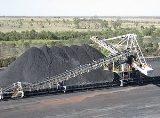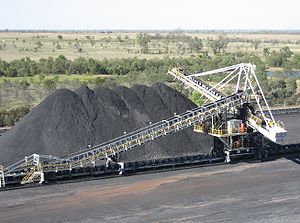
Stacker
Encyclopedia

Machine
A machine manages power to accomplish a task, examples include, a mechanical system, a computing system, an electronic system, and a molecular machine. In common usage, the meaning is that of a device having parts that perform or assist in performing any type of work...
used in bulk material handling
Bulk material handling
Bulk material handling is an engineering field that is centered around the design of equipment used for the handling of dry materials such as ores, coal, cereals, wood chips, sand, gravel and stone in loose bulk form...
. Its function is to pile bulk material such as limestone, ores and cereals on to a stockpile
Stockpile
A stockpile is a pile or storage location for bulk materials, forming part of the bulk material handling process.Stockpiles are used in many different areas, such as in a port, refinery or manufacturing facility. The stockpile is normally created by a stacker. A reclaimer is used to recover the...
. A reclaimer
Reclaimer
A reclaimer is a large machine used in bulk material handling applications. A reclaimer's function is to recover bulk material such as ores and cereals from a stockpile...
can be used to recover the material.
Gold dredge
Gold dredge
A gold dredge is a placer mining machine that extracts gold from sand, gravel, and dirt using water and mechanical methods.The original gold dredges were large, multi-story machines built in the first half of the 1900s....
s in Alaska had a stacker that was a fixed part of the dredge. It carried over-size material to the tailings
Tailings
Tailings, also called mine dumps, slimes, tails, leach residue, or slickens, are the materials left over after the process of separating the valuable fraction from the uneconomic fraction of an ore...
pile.
Stackers are nominally rated for capacity in tonne
Tonne
The tonne, known as the metric ton in the US , often put pleonastically as "metric tonne" to avoid confusion with ton, is a metric system unit of mass equal to 1000 kilograms. The tonne is not an International System of Units unit, but is accepted for use with the SI...
s per hour (tph). They normally travel on a rail between stockpiles in the stockyard. A stacker can usually move in at least two directions: horizontally along the rail and vertically by luffing (raising and lowering) its boom. Luffing of the boom minimises dust by reducing the distance that material such as coal needs to fall to the top of the stockpile. The boom is luffed upwards as the height of the stockpile increases. Some stackers can rotate the boom. This allows a single stacker to form two stockpiles, one on either side of the conveyor.
Stackers are used to stack in different patterns, such as cone stacking and chevron stacking. Stacking in a single cone tends to cause size segregation, with coarser material moving out towards the base. In raw cone ply stacking, additional cones are added next to the first cone. In chevron stacking, the stacker travels along the length of the stockpile adding layer upon layer of material.
Stackers and reclaimers were originally manually controlled, with no means of remote control. Modern machines are typically semi-automatic or fully automated, with parameters remotely set. The control system used is typically a programmable logic controller
Programmable logic controller
A programmable logic controller or programmable controller is a digital computer used for automation of electromechanical processes, such as control of machinery on factory assembly lines, amusement rides, or light fixtures. PLCs are used in many industries and machines...
, with a human-machine interface
Human-machine interface
Human-machine interface is the part of the machine that handles the Human-machine interaction- Overview :In complex systems, the human-machine interface is typically computerized. The term Human-computer interface refers to this kind of systems....
for display, connected to a central control system
Control system
A control system is a device, or set of devices to manage, command, direct or regulate the behavior of other devices or system.There are two common classes of control systems, with many variations and combinations: logic or sequential controls, and feedback or linear controls...
.
Other than stacking, a stacker has three basic movements:
- Luffing: This is vertical movement. Old stackers used a winch mechanism with metal wire, but newer ones are powered by hydraulic cylinders, generally two.
- Travelling: The stacker moves on a rail trackRail tracksThe track on a railway or railroad, also known as the permanent way, is the structure consisting of the rails, fasteners, sleepers and ballast , plus the underlying subgrade...
, which may be broadBroad gaugeBroad-gauge railways use a track gauge greater than the standard gauge of .- List :For list see: List of broad gauges, by gauge and country- History :...
or narrow gaugeNarrow gaugeA narrow gauge railway is a railway that has a track gauge narrower than the of standard gauge railways. Most existing narrow gauge railways have gauges of between and .- Overview :...
, enabling it to move around the stockyard as required. For this purpose, traction motors powered by direct current (DC) are connected by bevel gearBevel gearBevel gears are gears where the axes of the two shafts intersect and the tooth-bearing faces of the gears themselves are conically shaped.Bevel gears are most often mounted on shafts that are 90 degrees apart, but can be designed to work at other angles as well...
s to between 12 and 22 wheels. For manual control, all the controls are in a controller's cabin above the boom conveyor or boom. Modern stackers can be controlled remotely. - Slewing: This is rotation of the stacker around its central axis to align or place the stockpile where required. This works mostly by swel penion that rotates around a swel base. This type of gear assembly is called a sun and planet gearSun and planet gearThe sun and planet gear was a method of converting reciprocal motion to rotary motion and was utilised in a reciprocating steam engine....
. The awels may be multiple and are driven by DC-powered awel motors which transmit the torque via bevel or helical gears.
The conveyer belts used in stackers may be made of fabric or metal wire, depending upon the material to be handled. They are driven by pulleys, which in turn are driven by DC motor
DC motor
A DC motor is an electric motor that runs on direct current electricity.-Brush:The brushed DC electric motor generates torque directly from DC power supplied to the motor by using internal commutation, stationary magnets , and rotating electrical magnets.Like all electric motors or generators,...
s. The motors and gear are coupled by fluid coupling
Fluid coupling
A fluid coupling is a hydrodynamic device used to transmit rotating mechanical power. It has been used in automobile transmissions as an alternative to a mechanical clutch...
.
Most stackers are electrically powered by way of a trailing cable. There are basically two types of cable trailing: power cord rotating drum (PCRD) and control cable rotating drum (CCRD). Pendulum adjustments are made to ensure the proper alignment of these cables while the stacker is travelling.

